
By Armando Anaya H., Stanley Guenter, and Peter Mathews
Posted August 27, 2001.
Update: July 3, 2002
|
The existence of a carved wooden box from eastern Tabasco was reported to Armando Anaya Hernandez in June, 2001. The box was subsequently seen by Peter Mathews, Stanley Guenter, Raphael Tunesi and Joel Skidmore, as well as by Nikolai Grube and three companions. Mathews' preliminary field drawing is included with this report. (Please note that the shape of the box has been slightly idealized in this drawing. In fact the box has slighly outcurving sides.)
Preliminary field drawing - for printing
Free download: The box measures a maximum of 29.1 cm in length, and 7.1 cm in height. Its maximum surviving width is 9.7 cm; originally the box would have been about 10.5 cm wide. Only the "body" of the box survives, but a raised inner rim around its top edge indicates that originally it had a fitted lid. The species of tree from which the box was carved is not currently known. The box was reportedly found in a cave, along with human bones and ceramics, and four fragments of another wooden box. The other box fragments are not inscribed, and almost certainly these four pieces form one complete, but plain, box. It was reported that "cal" was found inside the box: at the suggestion of Raphael Tunesi, we wondered if this could mean fragments of stucco, perhaps from a codex. The dimensions of the cavity of the box are about 25 by 9.5 cm, within the range of the four surviving Maya codices. Unfortunately, the nature of this "cal" is not clear. From the surviving inscription, it is clear that the now-missing other long side of the box was carved with hieroglyphs, for the remaining long side's inscription begins mid-sentence. This means that all four sides of the box were carved with a hieroglyphic text. The bottom of the box is plain (though it has four small feet). It is not known of course what carving may have existed on the lid. The text as it exists makes reference to an individual who bears the illustrious titles Wite' Naah Ajaw (pL2-pM1) and Ochk'in Kaloomte' (pV-pW, pX-pY). These titles are known to have strong associations with Teotihuacan. The individual's name (pL1-pK2 and pU1-pU2) bears a remarkable resemblance to a lord named Tajom Uk'ab' Tuun who is mentioned on Piedras Negras Panel 2 in connection with a date in A.D. 510, the Maya date being 9.3.16.0.5 8 Chikchan 3 Keh. The wooden box has one surviving date (pM2-pN2) which unfortunately is almost completely eroded, but which is recorded as 1 [day] 6, 7, 8, or 9 [month]. The date is preceded by a short six-day Distance Number (pN1). It is noteworthy that if we add six days to the PN date 8 Chikchan 3 Keh, we would reach 1 Chuwen 9 Keh, consistent with what survives of the date on the box. If this is so, this box makes reference to an extremely powerful Teotihuacan lord of the early sixth century who appears to be a successor to the famous Siyaj K'ak' and Spearthrower Owl known from central Peten texts about 100 years earlier (see Mesoweb's excerpt of David Stuart's article, "Arrival of Strangers"). On the box, this Teotihuacan personage is named as the overlord of a local individual whose name sadly has not survived. The style of the glyphs is that of the eighth century, some 200 years later than the events that are discussed on the box. We believe that the person who commissioned the box was probably a descendant of the local lord who interacted with Tajom Uk'ab' Tuun of Teotihuacan. Further studies of the box and the implications of its text are ongoing. Only one other Precolumbian wooden box with glyphs is known to have survived into modern times. Known as the Tortuguero Box, it is also from Tabasco, Mexico. |
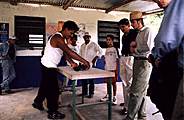
(click for zoom and caption) 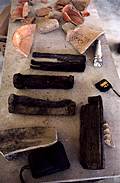
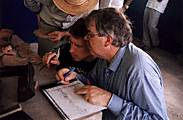

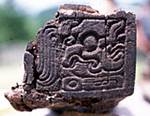
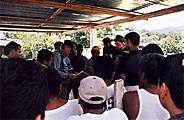
|
top - home